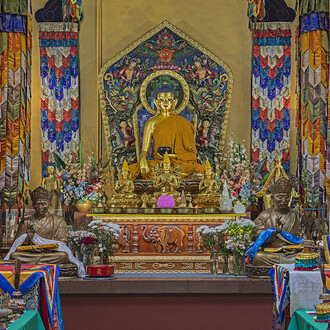On 10 December, the exhibition The Omani empire. Asia and Africa opens in the General Staff building of the State Hermitage. It is devoted to the period between the 17th and 19th centuries when Oman united its possessions on the Arabian peninsula and in Western Asia with the east coast of Africa and its inland territories.
“Oman is a country with a fascinating history across all times. The corner of Oman in the Hermitage successively reveals various chapters in that history. Today it is the turn of the maritime empire that drove out the Portuguese”, Mikhail Borisovich Piotrovsky, General Director of the State Hermitage, says.
The exhibition features items created during the reigns of the Yaruba (1624–1741) and Busaid (from 1746) dynasties. Under their rule, a maritime empire formed that reached the peak of its extent in the 19th century and continued to exist until 1964.
The exhibition demonstrates the might and splendour of that state and shows how multifaceted Omani culture altered as the territories in east Africa and Zanzibar were assimilated.
The display contains a variety of objects used in daily palace life: weapons that belonged to the Sultans of Oman and Zanzibar, decorations and medals, and a seal. Two Qurans that were in the personal possession of the Omani rulers will also be on show.
A dominant element in the exhibition area will be a throne made in the Sultanate of Zanzibar in the 18th century. Symbolizing Oman’s power in east Africa, it links the two halves of the display hall – male and female. That division is one of the most important in Muslim cultures and is widespread in the architecture of religious, palatial and residential spaces.
A separate theme within the exhibition will be the story of Zanzibar princess Emily Ruete (1844–1924), the first Arab woman to publish a book of memoirs. Besides the actual Memoirs of an Arabian Princess from Zanzibar, some of her personal possessions also tell about that exceptional woman’s unusual fate.
The exhibition The Omani empire. Asia and Africa has been organized as part of the long-standing collaboration between the State Hermitage and the National Museum of the Sultanate of Oman. This is already the second exhibition of artworks from Oman to be held in the Hermitage. In 2020, the exhibition “Oman: the Land of Frankincense” began a long run in the Hall of the History of Ancient Writings, telling about the ancient civilizations of Magan and of the Land of Frankincense, the migration of the Al-Azd tribes from Yemen and their subsequent settling of the internal regions of the Sultanate.
The curators of the new exhibition are Yevgenia Viacheslavovna Abroskina and Anna Vladimirovna Moiseyeva, both researchers in the Oriental Department.
The exhibition will be open to all holders of tickets to the General Staff building.
















